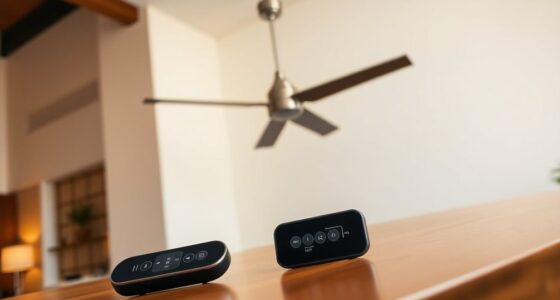Smart Life and Tuya aren't the same, but they're closely connected. Tuya is the parent company, while Smart Life is designed for everyday users looking for simplicity. You'll find Smart Life has a user-friendly interface, but Tuya offers extensive customization and scalability for businesses. Each platform handles data separately, so managing devices can get confusing. Plus, interfaces and automations differ, making it tricky to switch between them. If you want to learn how their features stack up or how to manage your devices efficiently, there's plenty more to explore about these platforms and their unique offerings.
Key Takeaways
- Tuya is the parent company, while Smart Life is an app developed by Tuya for consumer device management, operating independently.
- Smart Life focuses on user-friendly interfaces for consumers, whereas Tuya Smart offers extensive customization for enterprise applications.
- Device management and automation features are exclusive to each app, requiring users to manage devices separately across both platforms.
- Tuya Smart supports scalability for large IoT projects, while Smart Life is intended for individual consumers with limited enterprise capabilities.
- Both platforms struggle with integration complexities and data management, leading to potential confusion in smart home device tracking and management.
Overview of Tuya and Smart Life

Tuya and Smart Life are two integral parts of the smart home ecosystem. Tuya, the parent company, develops the Smart Life app to help you manage your smart devices easily.
While both platforms allow you to control a variety of devices, they operate independently, with separate data management systems. The Smart Life app provides a user-friendly interface designed for everyday consumers, making it simple to connect and control your devices.
In contrast, Tuya Smart focuses on extensive customization and scalability, catering to enterprise-level solutions. You might notice different levels of device compatibility and control features depending on your region and the manufacturer.
If you switch from Tuya Smart to Smart Life, be prepared to reset your devices for peak connectivity.
Customization and Branding

When it comes to customization and branding, the differences between the two platforms become even more apparent. Tuya Smart offers extensive options for businesses, allowing you to tailor both branding and functionality to your specific needs. In contrast, Smart Life focuses on a user-friendly interface with limited customization.
| Feature | Tuya Smart | Smart Life |
|---|---|---|
| Customization Level | Extensive | Limited |
| White-Labeling | Supported | Not supported |
| Documentation | Robust resources available | Lacks extensive documentation |
With Tuya Smart, you can maintain a strong brand identity, while Smart Life prioritizes individual consumer preferences. If you need deep customization, Tuya Smart is the clear choice.
Scalability and Project Suitability

While evaluating scalability and project suitability, it's clear that Tuya Smart is the go-to choice for enterprise applications.
Designed for large IoT projects, Tuya Smart supports thousands of devices simultaneously, making it perfect for businesses. In contrast, Smart Life targets individual consumers, lacking the robust scalability needed for complex B2B scenarios.
With Tuya Smart, you can manage bulk procurement of Tuya devices efficiently, deploying them across various locations with ease. Its advanced control features allow for granular operations, catering to diverse project needs, unlike Smart Life, which focuses on simplicity.
If you're looking to scale and customize your smart solutions, Tuya Smart certainly stands out as the superior option for your enterprise requirements.
Integration With Smart Ecosystems

When it comes to integrating with smart ecosystems, protocol compatibility is essential.
Tuya Smart shines with its support for Zigbee, Wi-Fi, and Bluetooth, while Smart Life's integration mainly focuses on voice control systems.
You might find challenges when trying to connect devices from manufacturer-specific apps with Smart Life, which can limit your overall smart home experience.
Protocol Compatibility
Although both Smart Life and Tuya offer smart home solutions, their protocol compatibility greatly impacts how well they integrate into existing ecosystems. Tuya Smart supports multiple protocols like Zigbee, Wi-Fi, and Bluetooth, enabling seamless communication among various devices. In contrast, Smart Life focuses on basic consumer integrations with limited capabilities for intricate ecosystems.
| Feature | Tuya Smart | Smart Life |
|---|---|---|
| Protocol Support | Zigbee, Wi-Fi, Bluetooth | Primarily Wi-Fi |
| Voice Control Integration | Alexa, HomeKit | Alexa, HomeKit |
| Local Control Challenges | Requires Tuya cloud access | Limited local connectivity |
While both apps can work with Home Assistant, you might face challenges in achieving local connections, especially with the Tuya App.
Ecosystem Integration Challenges
Integrating smart devices into a cohesive ecosystem poses significant challenges for users of both Smart Life and Tuya Smart.
The Smart Life app is user-friendly and excels in voice control compatibility with platforms like Amazon Alexa and Apple HomeKit. However, it lacks the advanced integration options you might need for complex projects.
On the other hand, Tuya Smart offers robust API capabilities, making it suitable for enterprise users, yet you may struggle with local control integration, often relying on cloud connections.
Both platforms also fall short in direct integration with services like Make, limiting your ability to automate actions across different platforms. This highlights the need for improved integration capabilities in both ecosystems.
User Experience and Interface

While both Smart Life and Tuya Smart apps aim to simplify smart home management, they cater to different user needs through their distinct interfaces.
The Smart Life app stands out with its user-friendly design, allowing you to manage your smart devices easily, perfect for everyday users. In contrast, the Tuya Smart app features a more complex interface tailored for businesses, requiring some technical expertise for effective setup and management.
Although both apps offer similar functionalities, Smart Life omits Tuya branding, creating a unique visual identity. You may encounter confusion maneuvering independent data systems for each app, particularly with features like Tap-to-Run and Automation.
Ultimately, your experience will differ based on which app aligns better with your smart home management needs.
Support and Resources

When it comes to support and resources, Tuya Smart clearly outshines Smart Life, especially for businesses.
If you're looking for robust support, here's what Tuya offers:
- Dedicated Account Managers: For bulk procurement clients, Tuya provides personalized assistance, ensuring your needs are met efficiently.
- Direct Access to Engineering Teams: You can resolve technical issues quickly by communicating directly with the experts who built the platform.
- Thorough Documentation and Training: Tuya users benefit from extensive guides and webinars that enhance their understanding of the platform.
While both platforms have customer support channels, Smart Life leans towards individual users, lacking the enterprise-level assistance that Tuya excels in.
For businesses, Tuya is the clear choice.
Data Management Differences

When switching between Smart Life and Tuya, you'll face challenges with device transfers, as each app requires you to remove and re-add devices independently.
This separation can lead to confusion, especially since automation settings don't carry over between the two platforms.
You'll need to manage your devices manually, which can complicate your experience if you're using both apps.
Device Transfer Challenges
Transferring devices between the Tuya Smart app and the Smart Life app presents significant challenges due to their independent data systems.
You'll need to navigate a cumbersome process that can lead to device downtime and confusion. Here are some key points to evaluate:
- Manual Management: You must remove devices from one app before re-adding them to another, requiring you to reconfigure all settings.
- Automation Loss: Automations and Tap-to-Run settings aren't shared, so you'll have to set them up again.
- Adaptation Required: Your device management practices must shift based on the app you choose, leading to potential frustration.
These device transfer challenges can make switching between apps more complicated than necessary.
Independent Data Systems
Switching between the Tuya Smart app and the Smart Life app is complicated not just by the device transfer challenges but also due to their independent data systems.
Each app handles its own data, meaning features like Tap-to-Run and Automation require you to maintain separate configurations.
When you want to transfer devices, you'll need to remove them from one app and re-add them to the other, which can be a hassle.
This independent data management can lead to confusion since any changes made in one app won't reflect in the other.
You'll need to be cautious when using both apps, as their isolated data systems demand manual device management to guarantee everything operates smoothly.
User Management Confusion
Although both the Smart Life and Tuya Smart apps aim to simplify smart home management, their independent data systems create significant user management confusion.
You need to be aware of the following:
- Device Transfer: You must remove devices from one app before re-adding them to the other, risking lost settings.
- Unique Automations: Tap-to-Run and Automation features are exclusive to each app, requiring separate management.
- User Interface Differences: The distinct interfaces and branding can mislead you about device management.
To avoid confusion, keep track of which devices and automations belong to Smart Life or the Tuya cloud.
This will help maintain proper functionality and a smoother smart home experience.
Troubleshooting and Connectivity Issues

When you're trying to connect Tuya devices to Home Assistant (HA) for local control, troubleshooting can be a frustrating experience. Many users find success only through cloud integration, which complicates local setups.
You might start by deleting and re-adding devices in the Tuya app or creating new projects. Configuring static IP addresses can also help resolve connectivity issues.
Don't forget to enable Intranet Access on your guest network settings; this often allows devices to reconnect and be pinged. Zigbee devices usually perform better due to their mesh networking, while Wi-Fi devices can struggle.
Additionally, be aware that manufacturer-branded apps may restrict access to their own cloud partitions, making integrations with HA more complicated.
Future Considerations and Developments

As the smart home landscape continues to evolve, both Smart Life and Tuya are poised to adapt to changing user needs and technological advancements.
Future considerations for these platforms will likely focus on:
- Enhanced Features: Expect updates that enhance functionalities based on user feedback and market trends.
- User Data Privacy: With growing concerns, both apps may incorporate local control options to bolster privacy.
- Compatibility: Future updates must address emerging smart home standards to guarantee seamless integration with new devices.
These developments will enhance user experience and satisfaction, making it vital for you to stay informed about the latest changes.
As the smart home ecosystem grows, both Smart Life and Tuya will continue to play significant roles in your connected living experience.
Frequently Asked Questions
Are Tuya Smart and Smart Life the Same?
No, Tuya Smart and Smart Life aren't the same.
While both apps come from Tuya Inc., they cater to different audiences. You'll find Tuya Smart designed for enterprises, offering extensive customization and advanced integrations.
On the other hand, Smart Life focuses on individual consumers, providing a simpler interface with limited customization.
If you're managing smart devices at home, Smart Life's your go-to, but for larger projects, Tuya Smart's the better choice.
What Are the Disadvantages of Tuya?
When you consider using Tuya, you might face several disadvantages.
First, their business model can make basic features feel limited, pushing you to pay for upgrades.
The platform's complexity might overwhelm you, requiring technical know-how for setup.
If your internet goes down, many devices won't work due to their reliance on cloud services.
You could also struggle with device compatibility and miss out on integrating with popular automation platforms like Make and Zapier.
What Is Better Than the Tuya App?
If you're looking for alternatives to the Tuya app, consider options like Home Assistant or Google Home.
Home Assistant offers extensive customization and flexibility for tech-savvy users, while Google Home provides a user-friendly experience with excellent integration for smart devices.
Both options excel in scalability and support various protocols, giving you more control over your smart home setup.
Evaluate your needs to find the best fit for you.
How Do I Transfer From Smart Life to Tuya?
To transfer from Smart Life to Tuya, you'll first need to remove your devices from the Smart Life app.
Unfortunately, there's no direct transfer option.
After that, reset your devices if necessary, and make sure they're connected to the same Wi-Fi network.
Then, open the Tuya app and follow the standard pairing process to re-add your devices.
You'll have to manage them manually in the new app, so stay organized!
Conclusion
In the end, while Smart Life and Tuya share a common foundation, they cater to different needs and preferences. Think of them as two sides of the same coin—each offering unique features and benefits. Whether you're looking for customization, scalability, or seamless integration, choosing the right platform can make all the difference in your smart home experience. So, weigh your options carefully and pick the one that fits your lifestyle like a glove!









